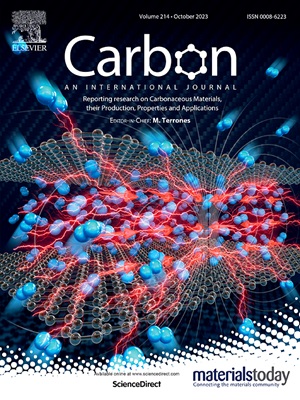Ethylene-induced welding of single-walled carbon nanotube films to enhance mechanical and optoelectronic properties
IF 10.5
2区 材料科学
Q1 CHEMISTRY, PHYSICAL
引用次数: 0
Abstract
Single-walled carbon nanotube (SWCNT) free-standing films combine high electrical conductivity with exceptional mechanical stability and optical transparency, opening the road for various applications: bolometers, thermophones, filters, etc. Here, we improve the performance of SWCNT free-standing films by engineering the intersections between the nanotube bundles –the building blocks forming and defining the conductivity and mechanical performance of the material. Hence, we propose a new, rapid, and scalable technology for the tailorable treatment of SWCNT free-standing films with ethylene (C2H4) under resistive heating. The technology comprises the high-temperature Joule heating of SWCNT free-standing films (700–1200 °C) combined with an exposure to ethylene flow at a pressure below 0.3 mPa, with an energy consumption as low as ca. 10 W/cm2. Using a set of methods (UV–vis–NIR and Raman spectroscopies, scanning and transmission electron microscopies, four-probe sheet resistance, temperature coefficient of resistance, and combined ultimate tensile strength/gauge factor measurements) combined with molecular dynamics simulations, we observe the film welding, i.e., the deposition of sp2 carbon coating presumably on nanotube bundle junctions. We show the welded free-standing films to enhance the performance of the filters and transparent electrodes (after doping with HAuCl4), strengthening the material up to an order of magnitude (ultimate tensile strength ∼ 22 MPa) and reaching one of the state-of-the-art performance values of 30 Ohm/sq at a transmittance of 90 % at 550 nm (electrical conductivity ∼ 30,000 S/cm).

求助全文
约1分钟内获得全文
求助全文
来源期刊

Carbon
工程技术-材料科学:综合
CiteScore
20.80
自引率
7.30%
发文量
0
审稿时长
23 days
期刊介绍:
The journal Carbon is an international multidisciplinary forum for communicating scientific advances in the field of carbon materials. It reports new findings related to the formation, structure, properties, behaviors, and technological applications of carbons. Carbons are a broad class of ordered or disordered solid phases composed primarily of elemental carbon, including but not limited to carbon black, carbon fibers and filaments, carbon nanotubes, diamond and diamond-like carbon, fullerenes, glassy carbon, graphite, graphene, graphene-oxide, porous carbons, pyrolytic carbon, and other sp2 and non-sp2 hybridized carbon systems. Carbon is the companion title to the open access journal Carbon Trends. Relevant application areas for carbon materials include biology and medicine, catalysis, electronic, optoelectronic, spintronic, high-frequency, and photonic devices, energy storage and conversion systems, environmental applications and water treatment, smart materials and systems, and structural and thermal applications.
 求助内容:
求助内容: 应助结果提醒方式:
应助结果提醒方式:


